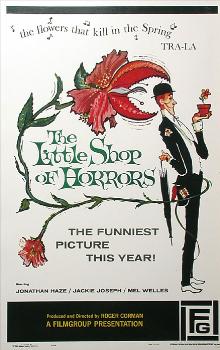The Little Shop of Horrors
| The Little Shop of Horrors | |
|---|---|

Theatrical release poster
|
|
| Directed by | Roger Corman |
| Produced by | Roger Corman |
| Screenplay by | Charles B. Griffith |
| Starring | |
| Narrated by | Wally Campo |
| Music by | |
| Cinematography |
|
| Edited by | Marshall Neilan, Jr. |
|
Production
company |
|
| Distributed by | Filmgroup |
|
Release date
|
|
|
Running time
|
72 minutes |
| Country | United States |
| Language | English |
| Budget | $28,000 |
| Box office | 25,066 admissions (France) |
The Little Shop of Horrors is a 1960 American black comedy horror film directed by Roger Corman. Written by Charles B. Griffith, the film is a farce about an inadequate florist's assistant who cultivates a plant that feeds on human flesh and blood. The film's concept is thought to be based on a 1932 story called "Green Thoughts", by John Collier, about a man-eating plant. However, Dennis McDougal in Jack Nicholson's biography suggests that Griffith may have been influenced by Arthur C. Clarke's sci-fi short story 'The Reluctant Orchid'.
The film stars Jonathan Haze, Jackie Joseph, Mel Welles, and Dick Miller, all of whom had worked for Corman on previous films. Produced under the title The Passionate People Eater, the film employs an original style of humor, combining black comedy with farce and incorporating Jewish humor and elements of spoof.The Little Shop of Horrors was shot on a budget of $28,000 in two days utilizing sets that had been left standing from A Bucket of Blood.
The film slowly gained a cult following through word of mouth when it was distributed as the B movie in a double feature with Mario Bava's Black Sunday and eventually with The Last Woman on Earth. The film's popularity increased with local television broadcasts, in addition to the presence of a young Jack Nicholson, whose small role in the film has been prominently promoted on home video releases of the film. The film was the basis for an Off Broadway musical, Little Shop of Horrors, which was notably made into a 1986 feature film and enjoyed a 2003 Broadway revival, all of which have attracted attention to the 1960 film.
...
Wikipedia
